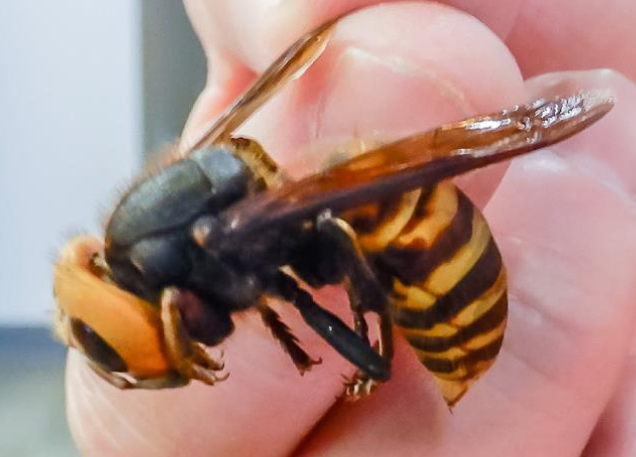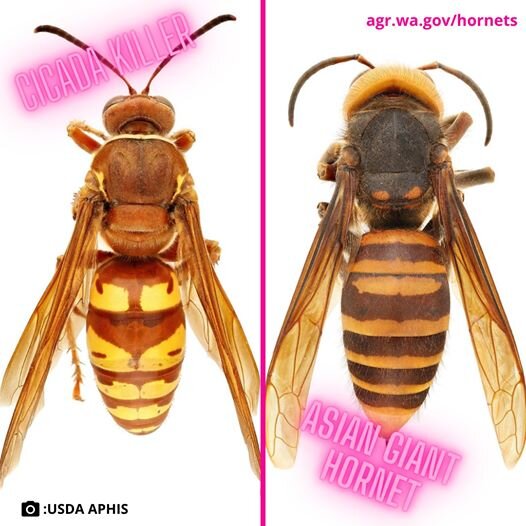Pest Alert: Asian Giant Hornet
/What is the Asian giant hornet?
The Asian giant hornet (Vespa mandarinia) is the world’s largest hornet and is native to Asia. The Asian giant hornet is a quarantine pest for the United States and is a serious pest of honeybees and other insects. A quarantine pest is a pest of potential economic importance, possibly present in the area of concern but not widely distributed, and officially regulated by the USDA APHIS. Learn more about quarantine pests by visiting the The Food and Agriculture Organization website.
ASIAN GIANT HORNET FOUND IN WASHINGTON STATE. FROM WA STATE DEPARTMENT OF AGRICULTURE HORNET PEST ALERT AGR PUB 809-816
Where has it been found?
In 2019, these hornets were found in British Columbia, Canada and Blaine, Washington. As of June 1, 2020, it has not been found in Oregon. However, if the Asian giant hornet does make its way into Oregon, it will threaten Oregon’s honeybees and poses a risk to humans. According to the Oregon Department of Agriculture, the Asian giant hornet is expected to attack the same things in this region that they attack in their native range: medium to large sized insects (large beetles, katydids, mantids, caterpillars).
MAP SHOWING REPORTS (AS OF JUNE 8, 2020) OF ASIAN GIANT HORNET FROM THE WASHINGTON DEPARTMENT OF AGRICULTURE’S HORNET WATCH REPORT FORM. VIEW THE CURRENT 2023 MAP HERE
Are they dangerous?
Yes! Use extreme caution near Asian giant hornets. While they do not generally attack people or pets, they can attack when threatened. Not only can the Asian giant hornet sting multiple times, their stinger is longer than that of a honeybee and the venom is more toxic than any local bee or wasp. Typical beekeeping protective clothing is not sufficient to protect you from stings.
Asian giant hornet Identification Tips:
Large wasps about 1.25 to nearly 2 inches long
Large, yellow-orange head with prominent eyes
Black and yellow striped abdomen
Forms large colonies that usually nest in the ground
Significant numbers of killed honeybees in or around a hive - they are typically snipped into pieces
IMAGE FROM WASHINGTON DEPARTMENT OF AGRICULTURE, BUGWOOD.ORG, AND USDA APHIS PPQ.
Does it look like other insects?
Some local insects have been confused with Asian giant hornets, including those listed below which are NOT Asian giant hornets. Remember, unlike the local insects below, Asian giant hornets are LARGE wasps 1.25 to nearly 2 inches long. Click here to view the Giant Hornet (Vespa mandarina) and Oregon Look-a-likes poster, which was created by Oregon Department of Agriculture.
Paper wasp
Bald faced hornet
Yellow jacket
Elm sawfly
The Washington State Department of Agriculture recently started a social media campaign called #ThatIsNotAnAsianGiantHornet which consists of putting a picture of an Asian giant hornet next to a picture of an insect that has been reported (but is not Asian giant hornet).
Credit: Dave Wilkes
Credit: Joel Nielsen
Credit: USDA APHIS
What should you do if you think you’ve seen an Asian giant hornet?
Do not kill what you think might be an Asian giant hornet and do not approach a suspected colony! Not only is it potentially dangerous, misidentification by well-intentioned members of the public can result in the killing of native bees and other insects. Instead, the Oregon Department of Agriculture (ODA) is asking that you report it immediately here: https://oda.fyi/HornetReport. If you do not have internet access, you can make a report by calling 503-986-4636.
Additional Resources:
Resources from the Washington Department of Agriculture:
Asian Giant Hornet Fact Sheet for farmers, gardeners, hunters, hikers, and outdoor workers. Available in Spanish: Farmers and outdoor workers
WSDA Virtual Press Conference (Recorded May 29, 2020): https://youtu.be/dzDgxBw48pM
The information above was compiled from the Oregon Department of Agriculture Pest Alert, Washington Department of Agriculture Hornet Webpage, and the USDA New Pest Response Guidelines for Asian Giant Hornet.
*Asian Giant Hornet Update from WSDA (7/24/2020)*
On July 24th, the Washington State Department of Agriculture (WSDA) released an Asian giant hornet stakeholder update. Below are a few important takeaways from the update:
Volunteers have put up over 1300 traps, which is in addition to the hundreds of traps managed by WSDA!
The Washington Invasive Species Council contributed $3,000 toward the cost of billboards in Whatcom County, WA to help raise awareness and encourage reporting of Asian giant hornets.
WSDA is partnering with the Washington State University Master Gardeners to provide a training (August 11 at 10 a.m.) for Master Gardeners who might be answering questions or receiving suspected Asian giant hornet specimens from clients. Master gardeners who are interested in participating in this webinar should contact their program coordinator for information on how to attend the training.
All Asian giant hornet stakeholder updates from WSDA can be found here. If you would like to receive updates from WSDA’s Pest Program on Asian giant hornet (and other topics), click here.









